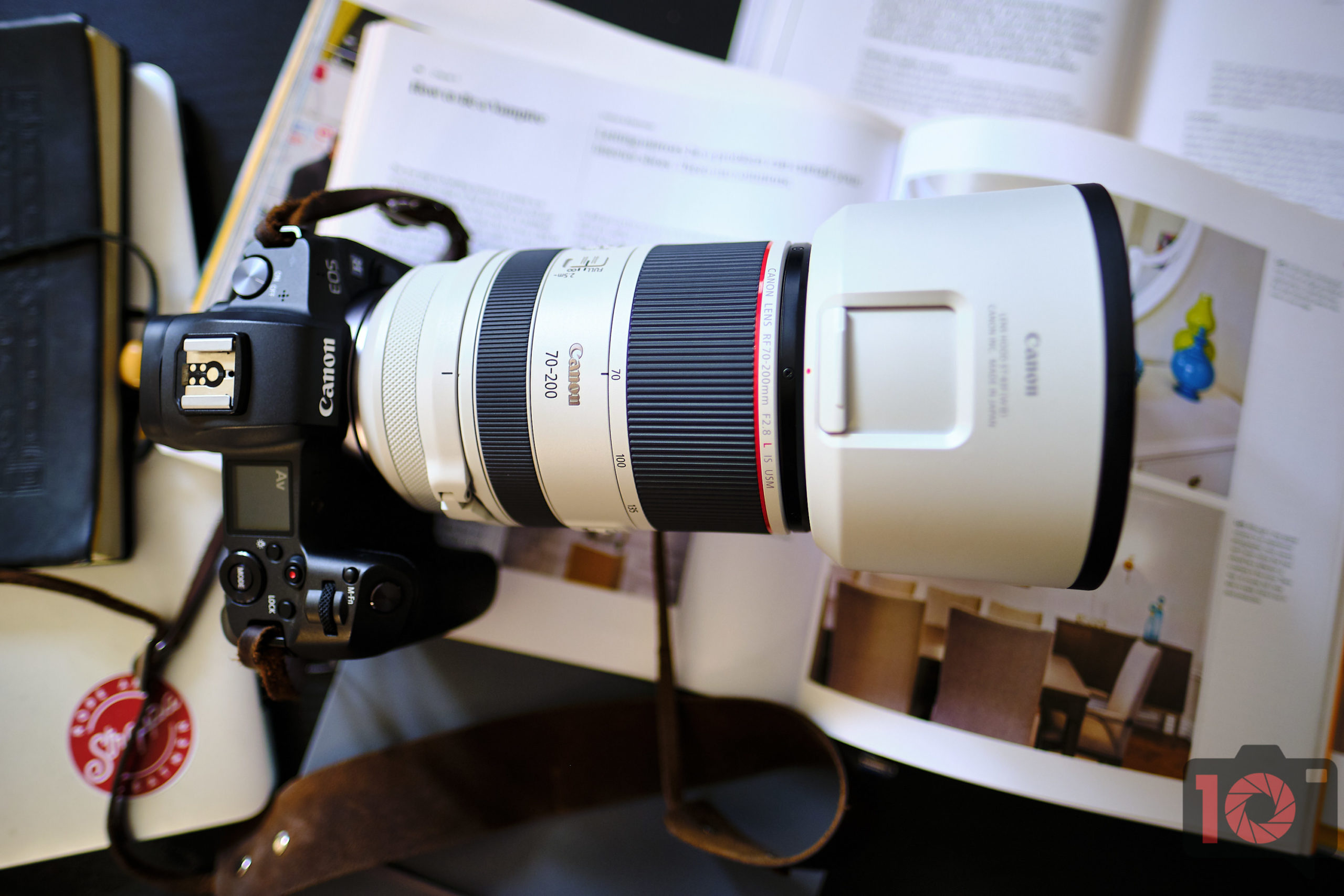Last Updated on 02/07/2023 by Brittany Smith
The Canon RF 70-200mm f2.8 L IS USM is arguably one of the most innovative zoom lenses made for Mirrorless.
After first laying eyes on the Canon RF 70-200mm f2.8 L IS USM nearly a year ago, I wasn’t sure what to expect when the review unit came in. What I didn’t realize is that it would quickly become one of my favorite telephoto zoom lenses. What’s more, it’s the first 70-200mm f2.8 lens I seriously considered purchasing. The secret to the Canon RF 70-200mm f2.8 L IS USM is the size. It becomes larger when it’s fully zoomed in, but, when set to 70mm, it’s shockingly small. Attach it to the Canon EOS R, and you can easily stuff it into a messenger bag. Then consider the image stabilization, Canon’s lens character, and the beautiful image quality it delivers. And let’s not forget that it survived a photo walk in the rain. In comparison to Sony’s option, the Canon RF 70-200mm f2.8 L IS USM is much more practical.
Table of Contents
Pros and Cons
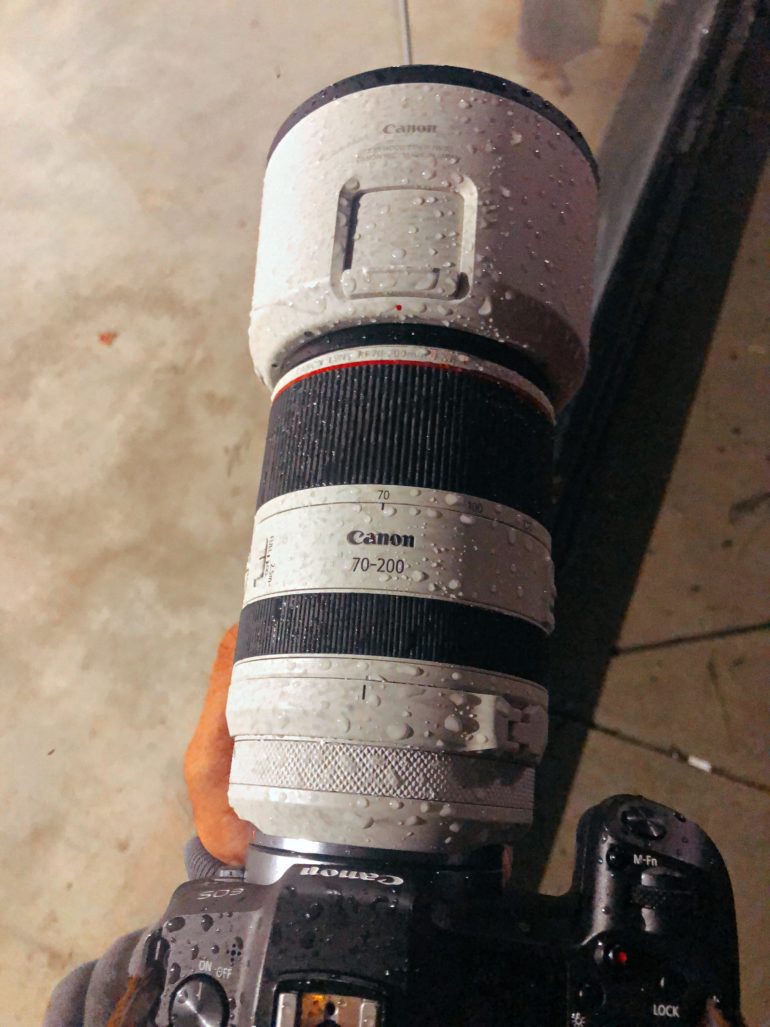
Pros
- It’s small
- See above
- Beautiful bokeh
- Pretty close focusing
- Nice, sharp images
- Fast-focusing and tracking
- Weather sealing
Cons
- The tripod collar is too large for its own good. Rotating it will only guarantee that it gets in the way of using the lens
- The control ring should probably be closer to the front of the lens, but we’re not sure how many folks are using it
Gear Used
We tested the Canon RF 70-200mm f2.8 L IS USM with the Canon EOS R, a Tiffen Circular Polarizer, and the Profoto B10.
Canon RF 70-200mm f2.8 L IS USM Tech Specs
Specs are taken from the Adorama listing:
- High Image Quality and Bright f/2.8 Aperture Telephoto Zoom RF L Lens.
- Compact and Lightweight.
- Optical Image Stabilization with up to 5 Stops* of Shake Correction.
- High Speed, Smooth and Quiet Auto Focus with Dual Nano USM.
- Minimum Focusing Distance of 2.3 ft./0.7m.
- Control Ring for Direct Setting Changes.
- 12 pin Communication System.
- Dust- and Water-resistant with Fluorine Coating.
- Two Aspherical Elements, One Super UD and One UD Lens
Ergonomics

The Canon RF 70-200mm f2.8 L IS USM is a wonder of a lens. Not only is it compact, but it’s also going to be familiar in the hands of a Canon user. Take a look; there are three main rings. Closest to the mount of the lens is the variable control ring. In my tests, I set this to aperture control to work the way I’m used to. In front of that is the focusing ring. And in front of that is the zoom ring.

On the side of the Canon RF 70-200mm f2.8 L IS USM are switches. You can find autofocus, focus limitations, image stabilization, and types of stabilization here. On the other side is the zoom lock.
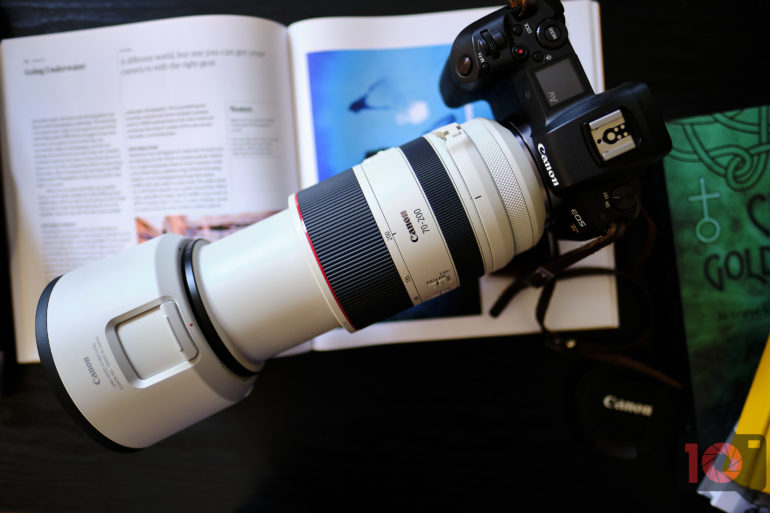
When the lens is zoomed in it will increase in size. But honestly, it’s still not that large when it comes to real life.
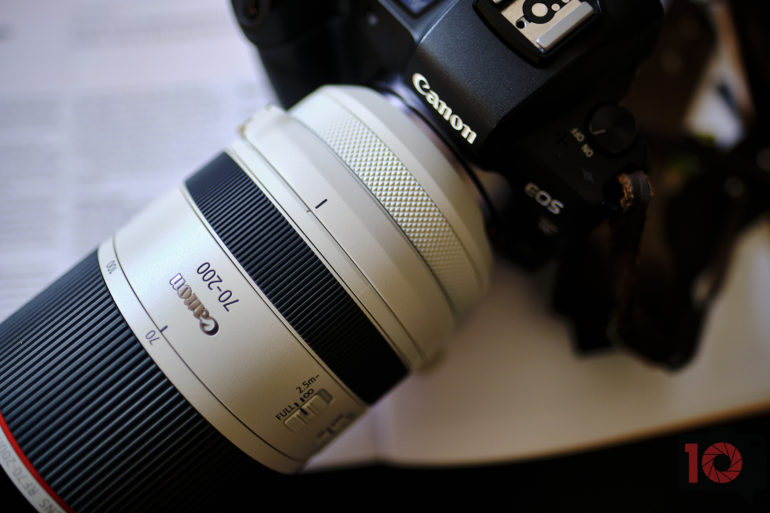
Here’s a closer look at the back control ring. I think this should have been further forward on the lens, near the Red L ring. But if you’re not going to use it (and I assume most folks won’t) then it’s best to leave it out of the way.
Build Quality
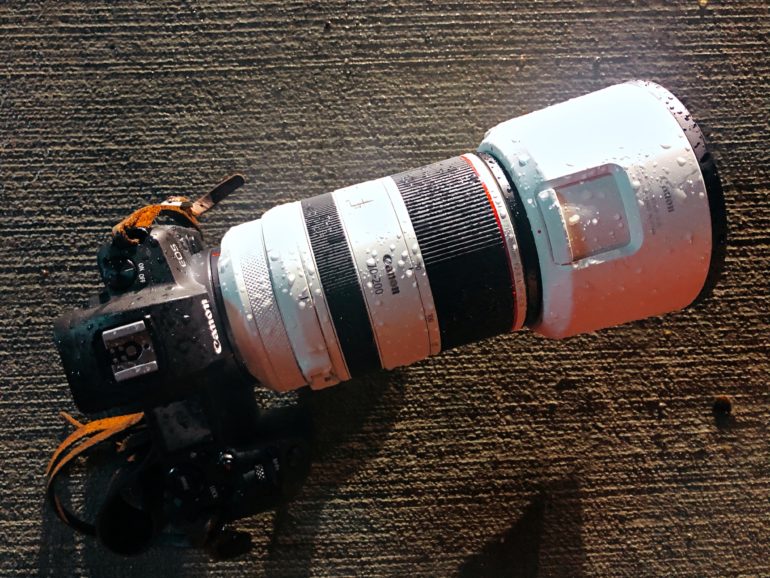
Take a look at the photo above. The Canon RF 70-200mm f2.8 L IS USM is touted as being weather resistant. In our tests, it proved to very much be the case. If you’re a photographer shooting a wedding and the weather takes a turn for the worse, your lens will be fine. If you’re a hobbyist (or like my Eye Doctor) and you love traveling with a lens like this, be aware that it’s going to survive pretty much whatever you throw at it. Indeed, it’s well built compared to a lot of what’s on the market.

Besides being weather-sealed, Canon should be commended for the size. When fully zoomed out, the lens attached to the Canon EOS R becomes easily portable in a camera bag. When you’re ready to use it, you unlock it and get to work. Sure, it’s going to extend when at the telephoto end, but who cares? When you’re already shooting, it won’t matter all that much, and I’m confident that you’re not going to poke an eye out when shooting an event either.
Ease of Use

The Canon RF 70-200mm f2.8 L IS USM is a pretty simple lens to use but has a few complications to it. There is a lock switch to start, and that prevents the Canon RF 70-200mm f2.8 L IS USM from ingzoom in. When stored, it also keeps the lens compact. There are switches like autofocus, focus limiters, and image stabilization. In my tests, I only accidentally switched on the focus limiter. Otherwise, this was all great except for the large lens hood. Unless you plan on actively using a monopod, I’d take the lens hood off.
Perhaps it’s also useful to talk about the image stabilization. For a focal length like this, it really matters and we’re glad it’s in there. Those of us who have been shooting for years have probably learned how to overcome the shakes. But for most of you who drink too much coffee, know that it’s there and then take your blood pressure pills.
Update February 2023
Lensrentals shipped out the Canon RF 70-200mm f2.8 lens with the updates installed alongside an R5 and R6 Mk II. It’s one of Canon’s larger RF zoom lenses. The heavy hitter is often utilized for capturing life’s most precious moments when the details matter.
The most recent updates have added image stabilization when attached to the R5 and R6 camera bodies. V1.0.8 takes it a step further and corrects focus breathing. The update makes it easier to capture longer exposures without a tripod.
Videographers are more concerned with focus breathing as they often zoom in and out as a measure of creativity. Although, fashion and event photographers will appreciate the swiftness and immediate accuracy on either end as they recompose. V1.0.8 does a fantastic job correcting it with these camera bodies. In video mode, the lens zooms in and out seamlessly. The Canon RF 70-200mm quickly achieves autofocus at both ends of the focal length without delay.
Commercial, portrait, and wedding photographers who depend on finite details will notice a boost in performance with focus stacking. It’s more user-friendly than ever when paired with the new EOS R5 and R6 renditions.
Autofocus

We tested the Canon RF 70-200mm f2.8 L IS USM in a variety of situations with the latest firmware update on the Canon EOS R as of January, 2020. Not only was it able to quickly track a subject, but its face detection abilities consistently surprised us. Even better, focusing in low light is fantastic. Sports photographers, photojournalists, event photographers, and others won’t have any major issues with the Canon RF 70-200mm f2.8 L IS USM when it comes to autofocus performance. Is it Sony level? No, but it’s not far off.







Image Quality

One of the best things about the Canon RF 70-200mm f2.8 L IS USM is the image quality. By and large, I wouldn’t consider this to be a lens about pixel peeping. However, it’s still very sharp if that’s what you’re aiming for. The lens has a character I’ve only ever seen in Canon lenses. Besides the beautiful bokeh, you’ll also be very happy with the colors it renders.
Bokeh

The bokeh from the Canon RF 70-200mm f2.8 L IS USM is creamy when shooting wide open. Portrait photographers, event photographers, and wedding photographers will care the most about this. While the bokeh is creamy, we have to be honest and say that it’s still not holding a candle to Canon’s f1.2 lenses. Here’s a quick show of what that’s like:

Above is a shot from the Canon RF 70-200mm f2.8 L IS USM

Here’s the Canon RF 85mm f1.2 L USM. It even has a disadvantage but the f1.2 aperture really helps!

Just for a comparison, here’s a shot from the Sony 70-200mm f2.8 G Master lens.

Here’s another shot from the Canon RF 70-200mm f2.8 L IS USM.
Chromatic Aberration

There is none. Let’s move on.
Color Rendition

Canon is known for its magic when shooting in Auto white balance. Everything looks nice where color is concerned, but what we also like doing is fixing the white balance to film temperatures. When we did this, we adored the look of the Canon RF 70-200mm f2.8 L IS USM’s output.
Sharpness

The real test of sharpness required us to shoot the Canon RF 70-200mm f2.8 L IS USM with a flash. And, well, you can see for yourself; it’s really sharp! Canon lenses have been known for years to be careful when it comes to rendering someone’s pores. You’ll going to see them for sure here. That’s just the nature of higher megapixels.


Extra Image Samples



























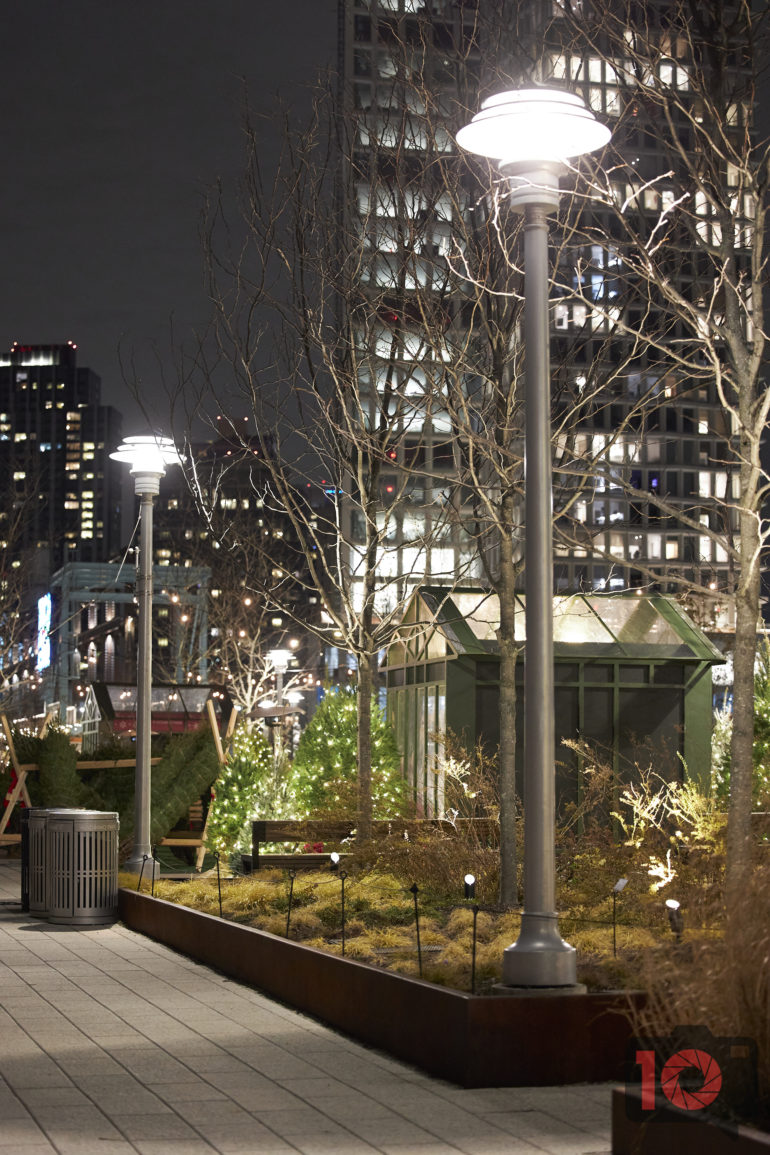

Conclusions
Likes
- Image quality
- Image stabilization
- Build quality
- The size
- Autofocus
- A fine example of Canon’s abilities when it comes to lenses in the Mirrorless world
- Beautiful bokeh
Dislikes
- It’s a bit pricey, but we understand why
We’re going to be honest here; the Canon RF 70-200mm f2.8 L IS USM isn’t exactly an impulse buy for all of us. But for those who earn taxable income from their photography, it makes sense. Not only is there image stabilization and exceptional build quality, but it’s got beautiful image quality. The bokeh is nice and creamy even though there are better portrait lenses on the market. The colors you’ll get are going to be much better than most of what you see on the market. And finally, with Canon’s great autofocusing abilities, you’re going to nail a shot in the dark. The Canon RF 70-200mm f2.8 L IS USM deserves high marks all around.

We’re awarding the Canon RF 70-200mm f2.8 L IS USM five out of five stars and our Editor’s Choice Award. Want one? Pick one up for around $2,699.


